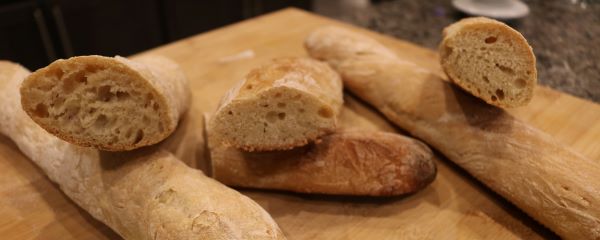
How to Bake Bread Without Bread Flour
It does not appear that the need for stress baking has come to an end. And I am not sure anything smells better than warm, homemade bread from the oven. No bread flour? Why not bake some bread without bread flour?
A while back I posted on how to bake bread without yeast. The recipes allow you to bake bread without bread flour or yeast because, at the time, it was impossible to find those ingredients. It is still a challenge to get them.
Where’s the Yeast?
Every time my husband or I went to the store yeast was on the list. We scoured that baking aisle every visit in case the missing ingredients were restocked. I ended up baking a lot of delicious bread using all-purpose flour and modifying the recipes provided at How to Bake Bread Without Yeast. The bread recipes are all very good, but that crusty baguette eluded me.

Then one glorious day I finally got my hands on a package of instant yeast. It was the second to the last package on the shelf which had a sign above it indicating “One per Customer”. Despite my husband and I standing there, we only took one bag. I hope I won’t regret it.
The amazement must have been overwhelming because I didn’t even think about looking for flour. There was plenty of all-purpose flour in the pantry, so it did not cross my mind to look for other kinds of flour. You know when you get so focused on something you get tunnel vision? That must have been what happened.
Well, the recently purchased yeast is a brand I have never seen before, but it is instant yeast. Part of me thinks yeast is yeast, but there was some room for pause as I was not quite certain how it compared to the yeast brand I normally used. How would it measure up? Are they very different? Would this new yeast produce the chewy, crunchy crust bread I craved?
Who needs bread flour?
Being really excited to try it out, I set aside some baking time. When I started going through my yeast bread recipes I found I had a significant item missing. Bread flour was not found anywhere in my pantry or freezer.
So my dreams of warm, chewy hot homemade baguettes with a crunchy crust from the oven were put on hold again. Sigh. So close and yet so far from the goal! Back to the store we went with the intent of finding bread flour.
For those of you perusing the grocery aisles for those hard to source items I know what you are facing and feeling. You head to the store list in hand and hope in your heart. Today will be different! Today I will find that item I have been looking for the last few weeks or months.
Entering the store, you grab a basket and with reserved joy head toward the designated aisle. With fingers crossed, you hope you will find your missing and much needed item. As you round the corner and begin the search you almost hold your breath. Will it be here today? Will today be my lucky day?
And then you spot the shelf — the empty shelf. Noooo! No bread flour. Just the ravaged, empty, sad shelf.
But then I remembered some research I had done about making my own bread flour substitute. So I searched farther down the aisle and low and behold there it was – Vital Wheat Gluten! I grabbed my secret weapon and headed home with a smile. Yes, I was going to bake light, yeasty bread after all!
How to Bake Bread without Bread Flour
Use Vital Wheat Gluten
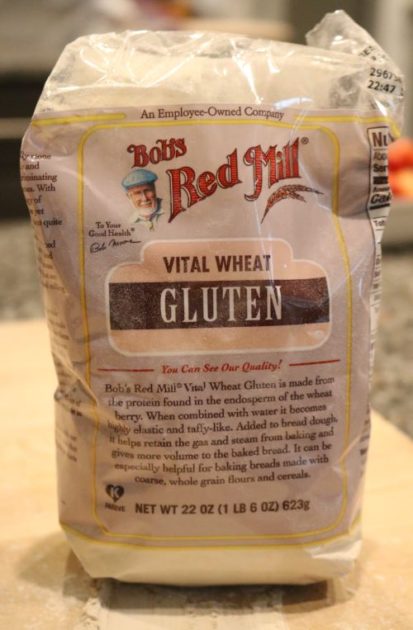
So what the heck is Vital Wheat Gluten? It is the natural protein found in the endosperm of the wheat berry. This protein is what gives elasticity and texture to the dough. You could say it is responsible for the chew in your bread.
When I was doing the research for Baking Flour Substitutions I came across several options. (If you would like my Baking Flour Substitutions card, I will send it to you! Just fill in the request below.)
I had two substitutions ready, but out of curiosity, I decided to do a comparison bake-off. So, I did some research and found a third option for the bread flour. Which bread would come out better?
The Options
Option one: substitute all-purpose flour for bread flour with no modifications.
Option two: use an algorithm to determine the amount of Vital Wheat Gluten to add to the recipe.
Option three: use a straight addition of Vital Wheat Gluten per cup of flour in the recipe.
To make the experiment even, I decided to use the same recipe for all three options. I went to my favorite easy bread channel on YouTube: Artisanbreadwithstev
There I found his “No Knead American Baguettes” recipe and video. It is quick, forgiving and very easy. Seriously, NO KNEADING. Play his video and follow along with his techniques. If you are new to bread making his channel is a great place to start. I don’t have his super cool baguette pan, but I do have a simpler model purchased a million years ago and used that.
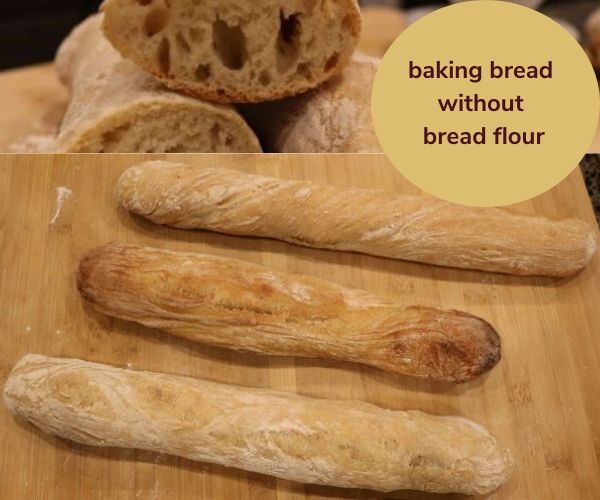
Option 1
Option one is the simplest, so it seemed like the place to start. Just use all-purpose flour for the bread flour in equal amounts. Would there really be that much of a difference since there was yeast to help it rise? All of the ingredients Steve uses (water, yeast, salt, olive oil) I used. Except where he used Bread Flour I substituted all-purpose flour. Following the instructions, it was left on the counter to proof overnight. This was done for the other options as well. I wanted all factors equal except the Vital Wheat Gluten.
All of Steve’s steps were followed through proofing, degassing, pre-shaping, resting, and baking. The baguettes baked for 25 minutes exactly, but you’ll want to keep an eye on your time as all ovens work a bit differently.
The Result: A flat baguette resembling a small ciabatta loaf with a very soft crust and almost gooey interior. No fluff or crumb to the loaf as if it had not cooked long enough. The butter just sat on top. It resembled store bought white bread. Ugh.
Option 2
Option 2 is actually the most difficult option, so hang on to your aprons. This particular bread flour substitute recipe was found on line and it is different from the one I use. But I thought what the heck. Since I am experimenting anyway, give it a shot. If you like math, this option is for you!
First, determine the amount of protein in your AP flour. Look at the ingredients table and it will give you x grams of protein per serving of flour. Mine read 3 grams of protein per ¼ cup. A quarter cup of flour weighs 34 grams. The formula for determining protein percentage is as follows:
- (x) grams of protein per (y) grams of flour
- (x) x 100 = (z)
- (z) / (y) = % of protein content in the flour
- My flour = 3 (x) grams per 34 (y) grams of flour
- 3 (x) x 100= 300 (z)
- 300 (z) / 34 (y) = 8.8 % flour protein
I rounded up and determined the flour protein is 9% for the brand I am using.
Next, we use the following formula to determine how much Vital Wheat Gluten to add to the recipe.
(Average Bread Flour Protein – AP Flour protein you are using) * 1% (recipe flour amount in grams) = Amount of Vital Wheat Gluten to add to your flour
Average bread flour protein is between 11 – 13% and a few sources say 12.7%. So I took the middle of the road and said 12%. The recipe calls for 3.5 cups of bread flour at 136 grams per cup = 476 grams of flour. One percent of that is 4.76 grams.
(12% – 9%) * 4.76 = 14.28 grams of Vital Wheat Gluten or just shy of 3.5 teaspoons.
So I measured 3.5 cups of AP flour and whisked in 3.5 teaspoons of Vital Wheat Gluten. Then following Steve’s baguette recipe again the dough sat overnight to proof. This time it really expanded in size and acted differently when I degassed and shaped the dough. It is very sticky so don’t be surprised when you work with the dough.
The baguettes were baked for exactly 25 minutes.
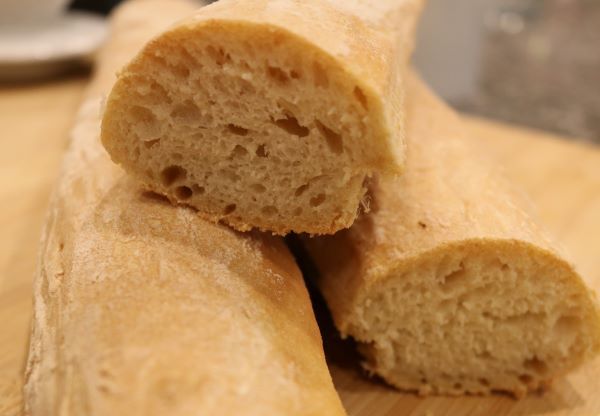
The Result: A slight headache from doing the math. As for the bread it was better than the first attempt. The crust was firm, but flexible. The crumb was still a bit small, but more noticeable and allowed the butter to melt into it. It definitely had a better chewiness to it and fluffier mouth feel, but it was still a little more dense and smaller than I wanted in a baguette.
Option 3
This one is quite straightforward. You just add 1.5 teaspoons of Vital Wheat Gluten for every cup of flour. The recipe calls for 3.5 cups of bread flour. I added (1.5 * 3.5) = 5.25 teaspoons of the gluten to my AP flour. I whisked them together and proceeded with Steve’s recipe.
It expanded like option two during the overnight proof, but seemed easier to work with during the shaping and resting. The timer was set for 25 minutes and I popped them in the oven.
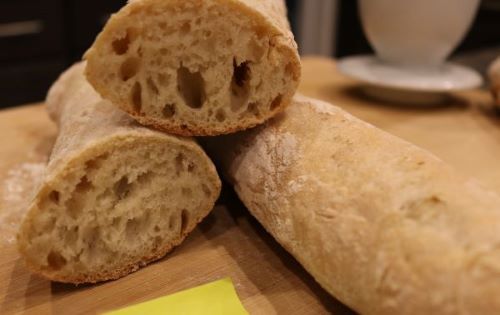
The Result: Exactly what I was looking for when I started this process! The loaf was larger and more evenly baked than the previous options. The crust was crunchy, not soft, and it crumbled when I broke apart the loaf. The interior had a lovely crumb, with large pockets to hold the melting butter. The texture was light and chewy and not the least bit gummy.
The Final Crust
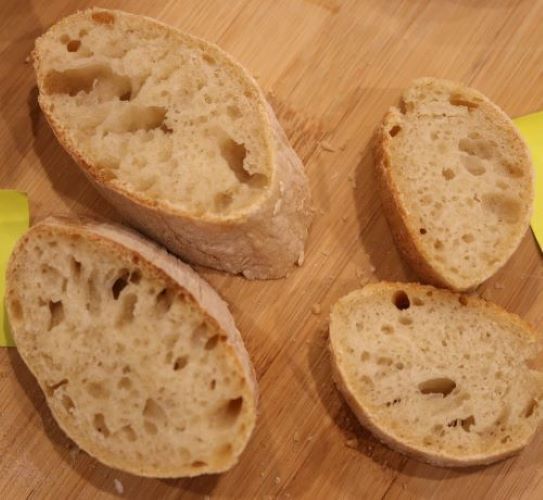
Sometimes the easier method is actually a very good method. I’ll be sticking with Option 3 from now on.
So friends, if you are in the mood to bake some bread and you don’t have any yeast I have three great recipes for you to try. You can find them on my post How to Bake Bread Without Yeast.
If you got lucky like I did and you found a bag of yeast or you bought yeast and bread flour before the shelves were emptied, then you can make all the bread and baked goods you desire – until you need more yeast.
If, however, you have yeast and don’t have bread flour then I hope this helps you. Vital Wheat Gluten is on your baking aisle. Grab yourself a bag and enjoy your stress baking session. Now you can bake really good bread without bread flour.
P.S. If you like this please share and add comments!
Cheers Y’all!






2 Comments
Srapp
Benefits of being the best friend! Was so fun baking, tasting and comparing. Thanks Rani for the great baking tips. Your baguettes were delish and the kitchen fun a lasting memory.
txredhead1836
This is exactly why I began this blog journey! To create beautiful memories and in the kitchen and help others do the same! It was such a good time with you being here! Rani